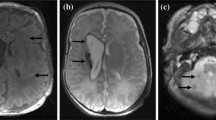Abstract
This report discusses the syndrome of amnionic bands, anencephaly, schizencephaly and hydranencephaly, four entities whose pathogenesis includes significant injury to the fetus in utero.












Similar content being viewed by others
References
Cincore V, Ninios AP, Pavlik J et al (2003) Prenatal diagnosis of acrania associated with amniotic band syndrome. Obstet Gynecol 102:1176–1178
Cignini P, Giorlandino C, Padula F et al (2012) Epidemiology and risk factors of amnionic band syndrome, or ADAM sequence. J Prenat Med 6:59–63
Guzmán-Huerta ME, Muro-Barragán SA, Acevedo-Gallegos S et al (2013) Amniotic band sequence: prenatal diagnosis, phenotype descriptions, and a proposal of a new classification based on morphologic findings. Rev Invest Clin 65:300–306
He P, Yang Y, Li D-Z (2012) Acrania associated with amnionic bands in a fetus. J Obstet Gynaecol 32:397–398
Tiwari VK, Sarabahi S, Mulla Rani UK (2013) Heterotopic implantation of amputated digits following constriction ring syndrome: a case series. J Plast Reconstr Aesthet Surg 66:1815–1817
Torpin R (1965) Amniochorionic mesoblastic fibrous strings and amnionic bands: associated constricting fetal malformations or fetal death. Am J Obstet Gynecol 91:65–75
Javadian P, Shamshirasaz AA, Haeri S et al (2013) Perinatal outcome after fetoscopic release of amniotic bands: a single-center experience and review of the literature. Ultrasound Obstet Gynecol 42:449–455
Calzolari F, Gambi B, Giampaolo G et al (2004) Anencephaly: MRI findings and pathogenetic theories. Pediatr Radiol 34:1012–1016
Yildirim H, Koç M, Kurt N et al (2009) Neonate with meroacrania: radiological findings and review of the literature. Diagn Interv Radiol 15:232–235
Bower C, D’Antoine H, Stanley FJ (2009) Neural tube defects in Australia: trends in encephaloceles and other neural tube defects before and after promotion of folic acid supplementation and voluntary food fortification. Birth Defects Res A Clin Mol Teratol 85:269–273
Heseker H, Mason JB, Selhub J et al (2009) Systematic review. Not all cases of neural-tube defect can be prevented by increasing the intake of folic acid. Br J Nutr 102:173–180
Copp AJ, Stanier P, Greene ND (2013) Neural tube defects—recent advances, unsolved questions and controversies. Lancet Neurol 12:799–810
Poretti A, Meoded A, Ceritoglu E et al (2010) Postnatal in-vivo MRI findings in anencephaly. Neuropediatrics 41:264–266
Szabó N, Gyurgyinka G, Kóbor J et al (2010) Epidemiology and clinical spectrum of schizencephaly in south-eastern Hungary. J Child Neurol 25:1335–1339
Packard AM, Miller VS, Delgado MR (1997) Schizencephaly: correlations of clinical and radiologic features. Neurology 48:1427–1434
Denis D, Chateil J-F, Brun M et al (2000) Schizencephaly: clinical and imaging features in 30 infantile cases. Brain Dev 22:475–483
Maeda T, Akaishi M, Shimizu M et al (2009) The subclassification of schizencephaly and its clinical characterization. Brain Dev 31:694–701
Yakovlev PI, Wadsworth RC (1946) Schizencephalies: a study of the congenital clefts in the cerebral mantle. I. Clefts with fused lips. J Neuropathol Exp Neurol 5:116–130
Yakovlev PI, Wadsworth RC (1946) Schizencephalies: a study of the congenital clefts in the cerebral mantle. II. Clefts with hydrocephalus and lips separated. J Neuropathol Exp Neurol 5:169–206
Rosenbloom L, Naidich TP (2013) Neuroepithelial cysts, porencephaly, and perivascular spaces. In: Naidich TP, Castillo M, Cha S, Smirniotopoulos JG (eds) Imaging of the brain. Elsevier, Philadelphia
Vaneckova M, Seidl Z, Goldova B et al (2010) Post-mortem magnetic resonance imaging and its irreplaceable role in determining CNS malformation (hydranencephaly)—case report. Brain Dev 32:417–420
Sepulveda W, Cortes-Yepes H, Wong AE et al (2012) Prenatal sonography in hydranencephaly. Findings during early stages of life. J Ultrasound Med 31:799–804
Quek Y-W, Su P-H, Tsao T-F et al (2008) Hydranencephaly associated with interruption of bilateral internal carotid arteries. Pediatr Neonatol 49:43–47
Conflicts of interest
The authors have no financial interests, investigational or off-label uses to disclose.
Author information
Authors and Affiliations
Corresponding author
Rights and permissions
About this article
Cite this article
Naidich, T.P., Griffiths, P.D. & Rosenbloom, L. Central nervous system injury in utero: selected entities. Pediatr Radiol 45 (Suppl 3), 454–462 (2015). https://doi.org/10.1007/s00247-015-3344-6
Received:
Revised:
Accepted:
Published:
Issue Date:
DOI: https://doi.org/10.1007/s00247-015-3344-6




